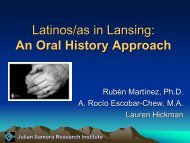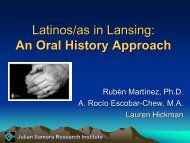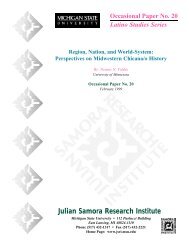Guanajuatense and Other Mexican Immigrants in the United States ...
Guanajuatense and Other Mexican Immigrants in the United States ...
Guanajuatense and Other Mexican Immigrants in the United States ...
Create successful ePaper yourself
Turn your PDF publications into a flip-book with our unique Google optimized e-Paper software.
Saénz, R. <strong>and</strong> A.I. Martínez (forthcom<strong>in</strong>g.). “Labor marketearn<strong>in</strong>gs of <strong>Mexican</strong>-orig<strong>in</strong> workers <strong>in</strong> non-metropolitanAmerica.” In Rural Lat<strong>in</strong>os: cross nationalperspectives. Penn State Press, Rural Studies Series.Sepúlveda Garza, M. 1994. “L<strong>in</strong>eamientos del procesoagrario en el este de Guanajuato 1920-1982.”Regiones, II (4): 187-196.Taylor, P. 1973. “<strong>Mexican</strong> labor colony at Bethlehem,Pennsylvania.” In Rosaldo, Renato, et. al., Chicano:<strong>the</strong> evolution of a people. M<strong>in</strong>nesota: W<strong>in</strong>ston Press.U.S. Bureau of Census. 1982. General population char -acteristics, Pennsylvania, Wash<strong>in</strong>gton, D.C.U.S. Bureau of Census. 1992. General population char -acteristics, Pennsylvania, Wash<strong>in</strong>gton, D.C.U.S. Bureau of Census. 1997. Current Population Sur -vey, Wash<strong>in</strong>gton, D.C.U.S. Bureau of Census. 1998. Population Projectionsfor <strong>States</strong>, by Age, Sex, Race <strong>and</strong> Hispanic Orig<strong>in</strong>,CB96-176, Wash<strong>in</strong>gton, DC.EndnotesAn earlier version of this article was presented at <strong>the</strong>National Association for Chicana <strong>and</strong> Chicano Studies <strong>in</strong><strong>the</strong> Centro Histórico, México, D.F., México, on June 24-27, 1998. It was given at a panel titled “Redes demigrantes <strong>Guanajuatense</strong>s en los Estados Unidos.”1. Similar processes are occurr<strong>in</strong>g <strong>in</strong> <strong>the</strong> meat-process<strong>in</strong>g<strong>in</strong>dustry across <strong>the</strong> country. <strong>Mexican</strong> workers are becom<strong>in</strong>g<strong>the</strong> majority <strong>in</strong> <strong>the</strong> labor force of this <strong>in</strong>dustry. Thisappears to be a trend <strong>in</strong> <strong>the</strong> meat <strong>and</strong> poultry plants <strong>in</strong> <strong>the</strong>U.S. Midwest, South, <strong>and</strong> East. For fur<strong>the</strong>r <strong>in</strong>formationsee Gouveia, forthcom<strong>in</strong>g <strong>and</strong> Horowitz <strong>and</strong> Miller (forthcom<strong>in</strong>g).2. The Federal Office of Management <strong>and</strong> Budget (OMB)designates <strong>and</strong> def<strong>in</strong>es metropolitan areas (MAS). These<strong>in</strong>clude metropolitan statistical areas (MSAs), consolidatedmetropolitan statistical areas (CMSAs), <strong>and</strong> primarymetropolitan statistical areas (PMSAs), of which MSAsare <strong>the</strong> most numerous.The underly<strong>in</strong>g concept of MSA is that of a core areaconta<strong>in</strong><strong>in</strong>g a large population nucleus, toge<strong>the</strong>r with adjacentcommunities hav<strong>in</strong>g a high degree of economic <strong>and</strong>social <strong>in</strong>tegration with that core. MSAcomposed of entirecounties, except <strong>in</strong> New Engl<strong>and</strong>, where <strong>the</strong> componententities are cities <strong>and</strong> towns. By <strong>the</strong> OMB’s current MASst<strong>and</strong>ards, each MSA must <strong>in</strong>clude ei<strong>the</strong>r a city with least950,000 people, or Census Bureau-def<strong>in</strong>ed urbanized area(UA), <strong>and</strong> total population of least 100,000 (75,000 <strong>in</strong>New Engl<strong>and</strong>).With<strong>in</strong> an area that meets <strong>the</strong> requirements to be anMSA<strong>and</strong> also has a population of one million or more, <strong>the</strong>OMB recognize <strong>in</strong>dividual component areas if <strong>the</strong>y meetspecified criteria <strong>and</strong> local op<strong>in</strong>ion supports <strong>the</strong>ir recognition.If recognized, <strong>the</strong> component areas are designated asPMSAs, <strong>and</strong> <strong>the</strong> entire area that conta<strong>in</strong>s <strong>the</strong>m becomes aCMSA. If PMSAs are not recognized, <strong>the</strong> entire area isdesignated as MSA. Metropolitan Areas, June 30, 1993,U.S. Maps, GE-90, no. 4.3. By subsistence farm<strong>in</strong>g or agriculture, <strong>the</strong> authors makereference to “agricultura temporal” [ra<strong>in</strong>-fed agriculture],as it is called <strong>in</strong> Mexico. This type of crop cultivationtakes place on marg<strong>in</strong>al l<strong>and</strong>s comprised of poor soils,uneven terra<strong>in</strong>, <strong>and</strong> no or little water for irrigation. Theparcels are small, under five hectares, <strong>and</strong> are primarilyused to grow subsistence crops, such as corn, beans, <strong>and</strong>squash. Some of <strong>the</strong> crops are also sold on <strong>the</strong> market.4. The term “Lat<strong>in</strong>os” refers to people whose orig<strong>in</strong>s are <strong>in</strong>Lat<strong>in</strong> America. This population <strong>in</strong>cludes U.S. citizensremoved from Lat<strong>in</strong> America over many generations, butwho acknowledge <strong>and</strong> trace <strong>the</strong>ir rich heritage to Mexico,Central America, <strong>the</strong> Caribbean, <strong>and</strong> what is commonlyreferred to as South America.5. “Chicanos” refers to people of <strong>Mexican</strong> descent, U.S.- <strong>and</strong>foreign-born, who reside <strong>in</strong> <strong>the</strong> <strong>United</strong> <strong>States</strong>. It is a selfidentityterm, <strong>and</strong> as such, members of this population mayor may not choose to call <strong>the</strong>mselves Chicanos. <strong>O<strong>the</strong>r</strong>smay prefer to call <strong>the</strong>mselves, tejanos, <strong>Mexican</strong> Americans,hispanos, or just “americanos.”6. The Central Plateau Region is a bas<strong>in</strong> with<strong>in</strong> <strong>the</strong>Cordilleran highl<strong>and</strong>s <strong>in</strong> central Mexico. It has numerousurban communities <strong>and</strong> <strong>the</strong> largest population concentration<strong>in</strong> <strong>the</strong> country. Increas<strong>in</strong>g population pressure <strong>and</strong> <strong>the</strong>l<strong>and</strong>-tenure system have stimulated a massive migration to<strong>Mexican</strong> Cities, <strong>the</strong> <strong>United</strong> <strong>States</strong>, <strong>and</strong> Canada.7. In May of 1994, <strong>the</strong> State of Guanajuato established LaDirección de Atención a Comunidades <strong>Guanajuatense</strong>s enel Extranjero. The objectives of this governmental officewas (i) to determ<strong>in</strong>e <strong>the</strong> number <strong>and</strong> location of <strong>the</strong> gua -najuatenses <strong>in</strong> <strong>the</strong> <strong>United</strong> <strong>States</strong>; (ii) to promote associationsof guanajuatenses <strong>in</strong> <strong>the</strong> <strong>United</strong> <strong>States</strong>; (iii) to workwith governmental <strong>and</strong> non-governmental agencies thatdeal with immigrants; (iv) to write <strong>and</strong> distribute anewsletter; (v) to visit <strong>the</strong> immigrants; <strong>and</strong> (vi) to lookafter <strong>the</strong> general well-be<strong>in</strong>g of <strong>the</strong> immigrants.8. The “core-send<strong>in</strong>g states” are Durango, Jalisco,Michoacán, Guanajuato, San Luis Potosí, Zacatecas,Tamaulipas, <strong>and</strong> Nuevo Leon. Peasants from <strong>the</strong>se stateshave migrated <strong>and</strong> immigrated to <strong>the</strong> <strong>United</strong> <strong>States</strong> s<strong>in</strong>ce







